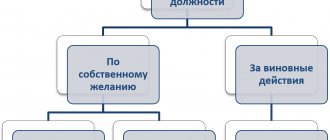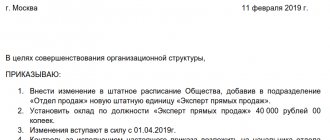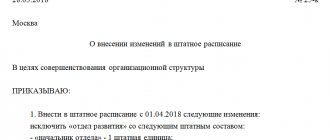Normative base
The traditional system of employee certification under current legislation is understood as a procedure, the content and procedure of which is developed by the employer independently. The Labor Code of the Russian Federation does not contain an article entitled “Certification of employees for suitability for the position held.” However, the Labor Code, in accordance with Article 81, determines that the certification procedure is established by the employer’s local regulations.
For example, certification of cultural workers is determined by the Procedure approved by the Deputy Minister of Culture of the Russian Federation, dated 02/08/2010 No. 7790-44/04-ПХ. This regulatory act, in particular, stipulates that employees who, due to the nature of their activities, do not require special skills or knowledge, for example unskilled workers, are not subject to certification.
There is a nuance: the employer develops the regulation on the certification of subordinates independently, taking into account the opinion of the trade union. But if there is no trade union in the organization, then there is no need to coordinate anything with anyone.
Read more: Personnel assessment and certification: learning to distinguish between them
Who is subject to certification for suitability for the position held?
According to the law, certification is not a mandatory procedure for all enterprises. At the same time, regulations and labor legislation establish this obligation only for certain types of activities.
Mandatory certification concerns:
- Civil civil servants of the Russian Federation, civil servants of the executive and state authorities of the Russian Federation, municipal employees of the Russian Federation;
- Heads of unitary enterprises;
- Employees of organizations of a certain type of activity. These include teachers, librarians, employees of aviation enterprises, and workers involved in the space field. This list also includes specialists who ensure the storage and destruction of chemical weapons, workers engaged in hazardous production, etc.
At all other enterprises, this procedure is carried out at the request of management. A prerequisite for its implementation is the need to record it in writing in local regulations, which must specify the conditions and procedure for certification activities.
Local regulations should determine which categories of personnel are subject to the procedure, as well as the list of employees exempt from this event.
The categories of employees who must undergo certification are determined by the personnel service or the organization’s management on an individual basis. At the same time, the following employees should be exempt from this procedure:
- Working in the relevant position for less than 12 months. This is due to the lack of required experience and work skills, so the results of certification activities may be erroneous;
- Pregnant women. Since even if a discrepancy is established, their dismissal is contrary to the law (Article 261 of the Labor Code of the Russian Federation);
- Employees on parental leave for children under 3 years of age. Such workers are allowed to be certified only 12 months after entering the workplace.
This list may additionally include employees employed under fixed-term employment contracts (concluded for less than 1 or 2 years), employees holding a certain part-time position, etc.
Regulations on employee certification
IMPORTANT!
Since in 2021 the certification of employees is regulated by the employer, we recommend taking as the basis for the development of an internal regulatory act the Regulation on the procedure for conducting certification, approved by Resolution of the USSR State Committee of October 5, 1973 No. 267.
The current legislation does not limit in any way the categories of employees in respect of whom certification can be carried out, as well as the frequency and procedure for certification. The employer has the right to establish, at its discretion, any procedure for carrying out this procedure in relation to any categories of employees.
We recommend that you approach the development of the document, which will be called “Regulations on Certification of Employees,” with care. In order to eliminate possible negative judicial practice, and also to ensure that the certification of employees for suitability for the position is as clear as possible to both employees and the employer himself, it is advisable to include the following sections:
- General information.
- Section on preparatory activities.
- Section on certification.
- Final provisions.
- Applications.
These sections are given as an example and do not claim to be universal. We want to give the employer a step-by-step algorithm so that the certification of workers at his enterprise does not fail and is as objective as possible.
Goals of certification activities
Attestation procedures at enterprises are mainly carried out with the aim of assessing the performance of employees and determining their suitability for their positions. This procedure also allows you to identify shortcomings in the level of preparedness of employees and draw up a plan for their individual development.
In addition, these events make it possible to determine the employee’s communication level (the degree of his cohesion with the team, teamwork, loyal attitude towards management and the enterprise as a whole), check his work motivation, and also identify possible prospects for his career growth.
The role of certification for the enterprise as a whole is to improve the level of employee management, as well as increase disciplinary responsibility and efficiency.
Another purpose of its implementation is to identify the category of employees who are subject to dismissal, as well as positions in case of reduction.
General section
Step 1. Identify the purpose of the certification
For one employer, it will be enough to write that the purpose of this event is to determine the compliance of the employee’s qualifications with the position he occupies.
Another may set out the goal of rational use of the labor resources of their employees, increasing the productivity of their work and responsibility for the assigned work. Formulate clearly and specifically exactly the goal you are trying to achieve.
For example, in accordance with the Regulations approved by Decree of the Government of the Russian Federation dated March 16, 2000 No. 234, the goals of certification of enterprise managers are:
- objective assessment of the performance of managers and determination of its suitability for the position held;
- providing assistance in improving the efficiency of enterprises;
- stimulating the professional growth of enterprise managers.
Step 2. Determine the composition of certified workers
Taking into account that the legislation does not limit the employer in choosing categories of employees for their certification, we still recommend NOT including in the lists of those certified:
- pregnant women;
- have worked in the position for less than a year;
- those on parental leave and employees who have worked for less than one year after returning to work from this leave;
- old age pensioners;
- minors;
- employees with whom a fixed-term employment relationship has been concluded.
The rest of the staff can be certified.
For example, when certification of prosecutorial employees is carried out, the following are not included in the list of those being certified:
- pregnant women;
- those on parental leave (they can be certified six months after leaving leave);
- workers who have reached the age limit for being in service (if they have not made significant omissions in their work);
- officers in the reserve of the military prosecutor's office upon assignment to their initial class rank.
All other employees of the prosecutor's office are subject to certification in accordance with Order of the Prosecutor General of June 20, 2012 No. 242.
Step 3. Set the frequency of certification
Certification can be carried out every year, but such frequency is unlikely to contribute to the formation of a healthy atmosphere in the team. Therefore, the optimal option would be a period no more than once every three years and at least once every five years.
For example, according to the text of Federal Law No. 342-FZ of November 30, 2011, certification of employees of internal affairs bodies is carried out once every four years.
Step 4. Specify the grounds for carrying out an extraordinary certification
It is better to provide (in case of separation) and record that an extraordinary certification can be carried out:
- by agreement of the parties;
- in case of changes in working conditions for technological reasons;
- in case of repeated improper performance of their official duties.
Then the employer will have the right to send the employee for an extraordinary certification, based on the results of which to make an appropriate decision, including that provided for in paragraph 3 of Article 81 of the Labor Code of the Russian Federation.
For example, in the Regulations approved by the Ministry of Transport of the Russian Federation dated March 11, 1994 No. 13/11 (registered with the Ministry of Justice on April 18, 1994 No. 548), early certification is carried out in cases where gross violations of the norms and rules governing the safe operation of vehicles are detected or committed transport accidents with serious consequences.
Provision of documents
Clause 14 of the Certification Regulations establishes the rules for submitting documents to the territorial commissions of Rostechnadzor.
| Required documents: |
|
| These documents can be sent to Rostechnadzor authorities: |
|
The third method of presentation is especially interesting. This is where a new concept is introduced – the Unified Testing Portal.
Section on preparation for certification
This section must clearly and clearly indicate what steps and measures the employer and his subordinate officials must take.
Step 1. Determine the composition of the commission
The composition of the commission is determined by order of the employer.
The commission must have a chairman, ordinary members and a secretary.
It is necessary to indicate which of them has the right to vote and who does not.
It is also important who will have the decisive voting right if the opinions of the commission members are distributed equally (to prevent this from happening, the commission should be created from an odd number of employer representatives).
The composition of the commission is permanent; changes can be made either due to a conflict of interest or due to personnel changes.
It is important to define the powers of the commission members. Thus, the chairman is responsible for the validity and legality of the collegial decisions made, the members of the commission are responsible for the comprehensiveness and objectivity of the decisions made, the secretary is responsible for technical work.
Step 2: Create a schedule
The certification schedule is a document that the employer draws up annually. Approved by a separate order. The schedule should be approved in advance in order to familiarize those undergoing certification with it.
The schedule states:
- list of employees subject to certification this year;
- date and place of the procedure;
- time for providing the necessary personnel documents for certified employees and full name. responsible for provision.
Step 3. Notify employees about the upcoming certification
All certified employees must be notified of the procedure in advance and signed. The employer decides how much in advance, but the optimal period is one month.
The form of the notification is not important, the fact that confirms familiarization is important.
If the employee refuses, a corresponding report is drawn up.
If you are sick, a corresponding notification is sent to the place of registration and residence by registered mail with acknowledgment of delivery.
Step 4. Obtain the necessary personnel documents
Due to the fact that the certification commission makes decisions based on the documents provided, the employer has the right to independently determine which document and within what time frame should be provided to the commission.
This could be any requirement, like, say, a portfolio.
For example, until recently, pedagogical workers of state-owned social service institutions in the Leningrad region were required to submit for certification a portfolio of a social worker characterizing the results of their activities. However, it is worth noting that this requirement has now been canceled by Order of the Committee for Social Protection of the Population of the Leningrad Region dated January 21, 2013 No. 1.
The procedure for certification of suitability for the position held
Certification activities can be divided into three stages:
- preparatory;
- the certification procedure itself;
- results and conclusions.
The preparatory stage is carried out by the personnel service and includes the preparation and generation of documentation (orders, lists of members of the certification commission, plan of activities, etc.), preparation of relevant certification materials (blanks, forms, etc.), and also the formation of methods and programs for carrying out this procedure.
Activities for direct certification include the preparation of reports (by certified employees and managers), filling out evaluation forms, analyzing results and holding commission meetings.
Procedure for certification
The stage of summing up results and conclusions involves preparing recommendations, conducting a procedure for analyzing the data obtained and approving them.
Sample portfolio of a social worker for certification
In practice, most often the employer requires the commission to provide a reference or performance review of the employee, which must be prepared by his immediate superior.
The employee's characteristics must be read and signed. After review, this document is submitted to the certification commission.
IMPORTANT!
It is necessary to provide for the opportunity for the employee to disagree with the content of his characteristics and provide written objections to the certification commission.
The deadline for submitting all documents is indicated in the schedule.
IMPORTANT!
Failure to provide a reference on time when the certification results are controversial is a formal reason for the court to declare the decision of the certification commission unlawful due to a violation of the procedure.
Certification commissions
The regulation on certification establishes the possibility of conducting certification by commissions created directly by organizations. An organization can create a main commission and separate commissions in separate divisions. In addition, you can create special commissions, for example, for a specific area of certification. To form an organization’s certification commission, members of the commission must undergo initial (periodic) certification in the TAK. In addition to the commission members, TAK undergoes certification:
- employees specified in subparagraphs “a” and “b” of paragraph 2 of the Certification Regulations (see above), with the exception of employees of organizations ensuring state security;
- employees specified in subparagraph “c” of paragraph 2 of the Regulations on Certification (see above), with the exception of employees of organizations ensuring state security - in cases where certification commissions of organizations have not been formed in the organizations.
Note!
“The employees of organizations specified in subparagraphs “a” - “c” of paragraph 2 of the Regulations that perform work or provide services to organizations operating hazardous production facilities, hydraulic structures, electric power facilities or energy receiving installations are certified by the certification commissions of organizations with which they are in labor relations , or in the certification commissions of organizations operating hazardous production facilities, hydraulic structures, electric power facilities or energy receiving installations (if this is provided for by the local regulations of such an organization).”
To implement the Decree of the Government of the Russian Federation No. 1365, Rostekhnadzor Order No. 424 dated November 6, 2021 approved the “Temporary procedure for the provision by the Federal Service for Environmental, Technological and Nuclear Supervision of state services for organizing certification in the field of industrial safety, on the safety of hydraulic structures, security in the electricity sector." It complements and deciphers some aspects of the Resolution regarding certification. Let us turn to the important points of this Order. According to clause 38 of the Procedure:
“The public service is provided on an extraterritorial basis in any territorial body of Rostechnadzor that provides the public service, at the choice of the applicant.”
This means that today the requirements for passing certification at the place of affiliation (registration) of the public organization or legal address are excluded. As part of the implementation of the provision, the territorial bodies of Rostechnadzor will provide public certification services on an extraterritorial basis - IN ANY TERRITORIAL DIVISION OF THE APPLICANT'S CHOICE. And the central commission is now entrusted with the authority to consider appeals against decisions made by territorial certification commissions.
Note!
In this case, the state fee must be paid to the payment details of the territorial body of Rostechnadzor, in which the applicant will undergo certification. In addition, you should refer to Appendix No. 1 of the Order, which contains the form of the application for certification. The following changes have been made to the statement:
- added categories of certified;
- The signature of the person being certified is required.
Section on certification
This section is a description of the step-by-step procedure for certifying employees at the enterprise.
Step 1. Determine quorum
To do this, the regulations must state that with the participation of two-thirds of the commission, its decisions are considered competent. If the number of commission members is smaller, the certification is postponed to another period determined by the employer taking into account the requirements of the described provision.
Step 2. Describe the procedure itself
We write that the certification of employees for compliance with the position held should be carried out in the presence of the employee himself and his immediate supervisor in a friendly atmosphere (the employee is already under stress).
We indicate that the boss represents the employee, and then the commission members ask questions that interest them.
After the questions are asked and the employee answers them, the employee being certified leaves, and his manager and members of the commission remain to discuss and make an appropriate decision.
After the decision is made, the employee is invited, and the chairman announces the decision of the commission to him.
Step 3. We fix the decision-making mechanism
Decisions are made by a majority vote on the basis of documents received by the commission and on the basis of information provided by the boss and the employee being certified.
IMPORTANT!
Any decision must be justified and supported by the relevant document. If an employee is a scoundrel, this is not a reason to recognize him as unsuitable for his position.
The professional activity of an employee must be assessed in relation to the qualification requirements for his position. It is necessary to take into account the employee’s personal contribution to achieving the goals of the organization, as well as the complexity and intensity of the work he performs.
It is worth paying attention to the absence or presence of facts of violations of labor regulations and job responsibilities.
If the votes are equally divided, the chairman has the casting vote.
All doubts are interpreted in favor of the employee.
Step 4. Commission decision options
We describe what decisions the commission can make:
- the employee is suitable for the position held;
- send for training to suit the position;
- petition the employer for an increase (salary, position);
- consider demotion to the current position due to insufficient qualifications;
- does not correspond to the position held, recommend sending him to training to improve his qualifications or dismiss him due to insufficient qualifications.
Step 5. We formalize the commission’s decision.
All decisions of the commission are documented in a protocol or entered into the employee’s certification sheet. It makes no sense to draw up both documents; in essence, they are the same thing, only the form is different. At the same time, no one forbids filling out both documents.
The certification sheet and protocol are signed by all members of the commission present at the certification.
IMPORTANT!
Those members of the commission who were not present at the certification do not have the right to sign these documents. If they sign, this may serve as a reason to cancel the commission’s decision and initiate a criminal case under Article 292 of the Criminal Code of the Russian Federation.
Next, the certification sheet (and the protocol, if available) is sent to the personnel department, where, based on this document, an order of the appropriate content will be issued.
The order must be issued within a certain period, the employer himself will determine which, but not more than one month.
It is necessary to ensure that the deadlines can be interrupted (when going on vacation, temporary absence for unknown reasons or temporary disability, this period must be interrupted).
Violation of deadlines entails cancellation of the decision by the certification commission.
For example, if A.V. Petrov will be recognized as unsuitable for his position, the employer has the right to fire him, send him to training or demote him (his will, the certification commission has granted him such powers).
If the employer decides to move A.V. Petrov to a lower position, and A.V. Petrov refuses, the employer will have the right to fire him on the same grounds.
Step 6. Employee rights
It is advisable to indicate that in case of disagreement with the results of the certification, the employee may appeal this decision in accordance with the procedure established by law.
Certification results
An employee who has passed the inspection is given an attestation sheet - the final control document. It is not unified, so it is compiled in free form. The document must indicate:
- date of assessment;
- employee details: full name, education, position in accordance with the staffing table, length of service in this position, total length of service;
- control questions that were asked during the inspection;
- answers on questions;
- test result;
- signatures of commission members;
- employee’s signature confirming familiarization with the document.
If there are any additions or notes, they are also recorded in the resulting sheet.
Legal documents
- Article 261 of the Labor Code of the Russian Federation
Final provisions
This section contains information about where to store certification documents. All certification documents are stored in personnel departments, protocols - in the nomenclature folder, certification sheets - in the personal files of employees.
The storage period for these documents is 75 years.
Sample regulations on employee certification
Sample schedule for employee certification
Sample characteristics for an employee for certification
Sample employee certification protocol
Sample certification sheet
Read more: Peculiarities of teacher certification. New initiatives
Read more: The procedure for certifying teaching staff for compliance with the position held
Read more: How to certify the head of an educational institution
Read more: How can a teacher pass voluntary certification?
Requirements for students
Also, Decree of the Government of the Russian Federation No. 1365 approves the requirements for the documents provided by workers who must receive additional training in industrial safety (according to paragraph 1 of Article 14.1 of the Federal Law “On Industrial Safety of Hazardous Production Facilities”). According to clause 13 of the Regulations on certification in the field of industrial safety:
“... the application for certification will need to be accompanied by copies of qualification documents obtained within 5 years preceding the date of its submission, based on the results of additional professional education in the field of industrial safety in additional professional programs corresponding to the declared area of certification.”
Unified testing portal
This portal began operating on November 1, 2021. You can find it at www.gosnadzor.ru/eptb The Regulations indicate that as of November 1, 2021, everyone is required to conduct certifications only using a single testing portal both in RTN and in the commissions of organizations. In fact, this means that Rostechnadzor will now maintain a register of all certified persons, including those who have confirmed their knowledge in the commissions of organizations (clause 20):
“Certification commissions of organizations conduct certification using the tools of the Unified Testing Portal. A local regulatory act of an organization may establish additional forms of certification in the organization’s certification commission.”
Note!
1. “Additional forms” in no way cancel certification through the EPT. 2. Passing certification through the EPT is only for managers and specialists of the organization, this does not apply to workers (such as slingers, crane operators, etc.). The certification requirements for them have not changed!
VI. Procedure for certification of military personnel certification commissions
VI. The procedure for certification of military personnel,
certification commissions
Article 26. Procedure for certification of military personnel
1. For the purpose of a comprehensive and objective assessment of military personnel undergoing military service under a contract, determining their suitability for the military position held and the prospects for further official use, as well as determining the purpose of citizens in the reserve, certification is carried out.
(as amended by Decree of the President of the Russian Federation dated January 2, 2015 N 3)
2. The main objectives of certification of military personnel are:
a) determining the suitability of military personnel for their military positions and the prospects for their further official use;
b) selection of military personnel for appointment to military positions, determining the feasibility of concluding new contracts with military personnel who have reached the age limit for military service, as well as selecting candidates for sending to study;
c) creating a reserve of candidates for nomination and placement for study;
d) determining the career destination of graduates of military educational institutions;
e) nomination of military personnel for state awards of the Russian Federation and assignment of the next military ranks ahead of schedule and one step higher than the military ranks provided for by the state for the military positions held;
f) assessment of the reasons that may serve as grounds for the early dismissal of a serviceman from military service.
3. The procedure for organizing and conducting certification is determined by the head of the relevant federal executive body or federal government body in which the certification is carried out.
(as amended by Decree of the President of the Russian Federation dated December 18, 2016 N 675)
4. Military personnel performing military service under a contract are certified no less than four months before the expiration of their military service, but no less than every five years of military service, as well as upon completion of a military educational institution, postgraduate studies, or military doctoral studies.
The paragraph became invalid on January 1, 2010. — Decree of the President of the Russian Federation dated August 20, 2007 N 1084.
5. If necessary, the head of the federal executive body or the federal state body that provides for military service has the right to set the time and procedure for certification of all military personnel undergoing military service under a contract, or individual categories of them.
(as amended by Decree of the President of the Russian Federation dated December 18, 2016 N 675)
6. An attestation sheet is drawn up for the serviceman being certified by his immediate (direct) superior from among the officers.
When a serviceman is appointed to a senior military position, sent to study, nominated for a state award of the Russian Federation, assigned a military rank ahead of schedule or one step higher than the military position held, an attestation sheet is not drawn up. In these cases, the certification commission considers the submission (award sheet) or the decision of the commander (chief) to send the serviceman to study. The conclusion of the certification commission is entered into the submission (award sheet).
The serviceman must be familiar with the content of the certification, which is indicated on the approved certification sheet.
7. The commander (chief) certifying a subordinate military man, in accordance with the certification procedure, is obliged to:
a) comprehensively study and evaluate the business and personal qualities of the certified military personnel;
b) determine, on the basis of a comprehensive study of the serviceman, the content of the conclusions on his certification;
c) upon command, submit to the approving authority all copies of the certification sheets to obtain a conclusion and approval.
8. When studying and assessing the business and personal qualities of a certified serviceman, the commander (chief) is obliged to:
a) analyze and evaluate the specific performance indicators of the certified serviceman for the military position he occupies, the state of affairs in the military unit (unit) he commands, or in the area of work for which he is responsible;
b) conduct an individual conversation with the certified serviceman on issues of his military service, improving professional training, style and methods of his work;
c) provide the necessary advice and recommendations to eliminate the shortcomings of the certified military personnel, improve personal training and perform his official duties.
9. The commander (chief) is responsible for the objectivity of the certification and the validity of the conclusions and recommendations stated in it.
Immediate superiors must demand that subordinates eliminate shortcomings and provide them with assistance in this, ensure the implementation of certification conclusions, and prevent unreasonable delays in the appointment of worthy military personnel to senior positions and in sending them to study.
10. Certification conclusions and the procedure for conducting certification can be appealed by a military personnel to a higher commander (chief) within a month from the date the certification results were announced to him, as well as in court.
If the serviceman’s complaint is found to be justified, appropriate changes are made to the certification sheet or a new certification sheet is drawn up.
Article 27. Certification commissions
1. To conduct certification, as well as resolve other issues of military service in military units from a separate battalion, equal to it and above, certification commissions are created.
The certification commission is accountable to the commander of the military unit in which it was created.
2. The composition of the certification commission is announced by order of the commander of the military unit.
The certification commission includes:
a) the chairman of the certification commission - the first deputy (deputy) commander or chief of staff of a military unit;
a.1) deputy chairman of the certification commission - deputy commander of a military unit for military-political work (in the Armed Forces of the Russian Federation and other troops);
(clause “a.1” was introduced by Decree of the President of the Russian Federation dated July 1, 2020 N 440)
b) members of the certification commission - deputy (deputies) commander of a military unit, commanders (chiefs) of units of a military unit, representatives of personnel and legal bodies, recruitment bodies and military-political bodies (educational bodies) of a military unit;
(as amended by Decree of the President of the Russian Federation dated July 1, 2020 N 440)
c) the secretary of the certification commission is one of the officers of the military unit;
d) other persons for the purpose of considering certain issues related to the performance of military service by military personnel, in accordance with the decrees of the President of the Russian Federation.
(paragraph “d” was introduced by Decree of the President of the Russian Federation dated July 1, 2010 N 821)
3. At the meeting of the certification commission the following are considered:
a) the results of the serviceman’s certification;
b) candidates for military service under contract;
c) candidates for appointment to military positions, as well as the advisability of concluding new contracts, including contracts with military personnel who have reached the age limit for military service;
d) candidates for referral to study;
e) nominations for state awards of the Russian Federation for military personnel and civilian personnel of military units;
f) submissions for assignment to the next military rank ahead of schedule or one step higher than the military rank provided by the state for the military position held;
g) submissions for early dismissal from military service of military personnel dismissed by decision of the command or at their own request;
h) other issues for which, in accordance with the Federal Law, these Regulations and other regulatory legal acts, the conclusions of the certification commission are required;
i) other issues related to military service by military personnel, in cases provided for by federal laws, decrees of the President of the Russian Federation, or by decision of the commander of a military unit.
(paragraphs “and” as amended by Decree of the President of the Russian Federation dated July 1, 2010 N 821)
4. To make a decision by the commander of a military unit, the certification commission issues written opinions on all issues under consideration.
5. If necessary, military personnel being certified, commanders (chiefs) of units subordinate to the military personnel being certified, and other officials may be invited to meetings of the certification commission of a military unit.
6. A central certification commission is created in the Ministry of Defense of the Russian Federation (the federal executive body or the federal state body that provides for military service).
(as amended by Decree of the President of the Russian Federation dated December 18, 2016 N 675)
The work procedure, composition and tasks of the central certification commission are determined by the head of the federal executive body or the federal government body in which military service is provided.
(as amended by Decree of the President of the Russian Federation dated December 18, 2016 N 675)









